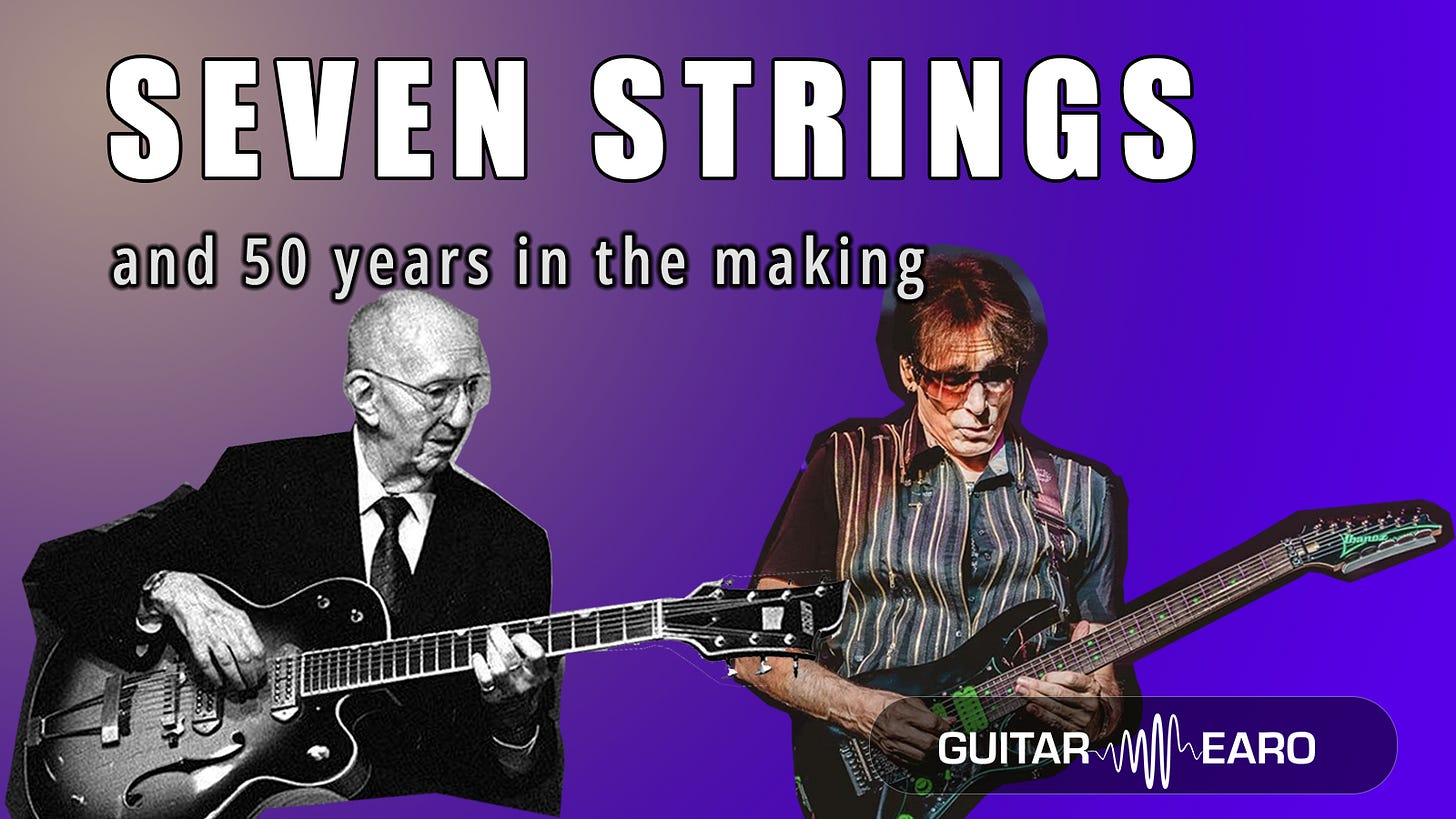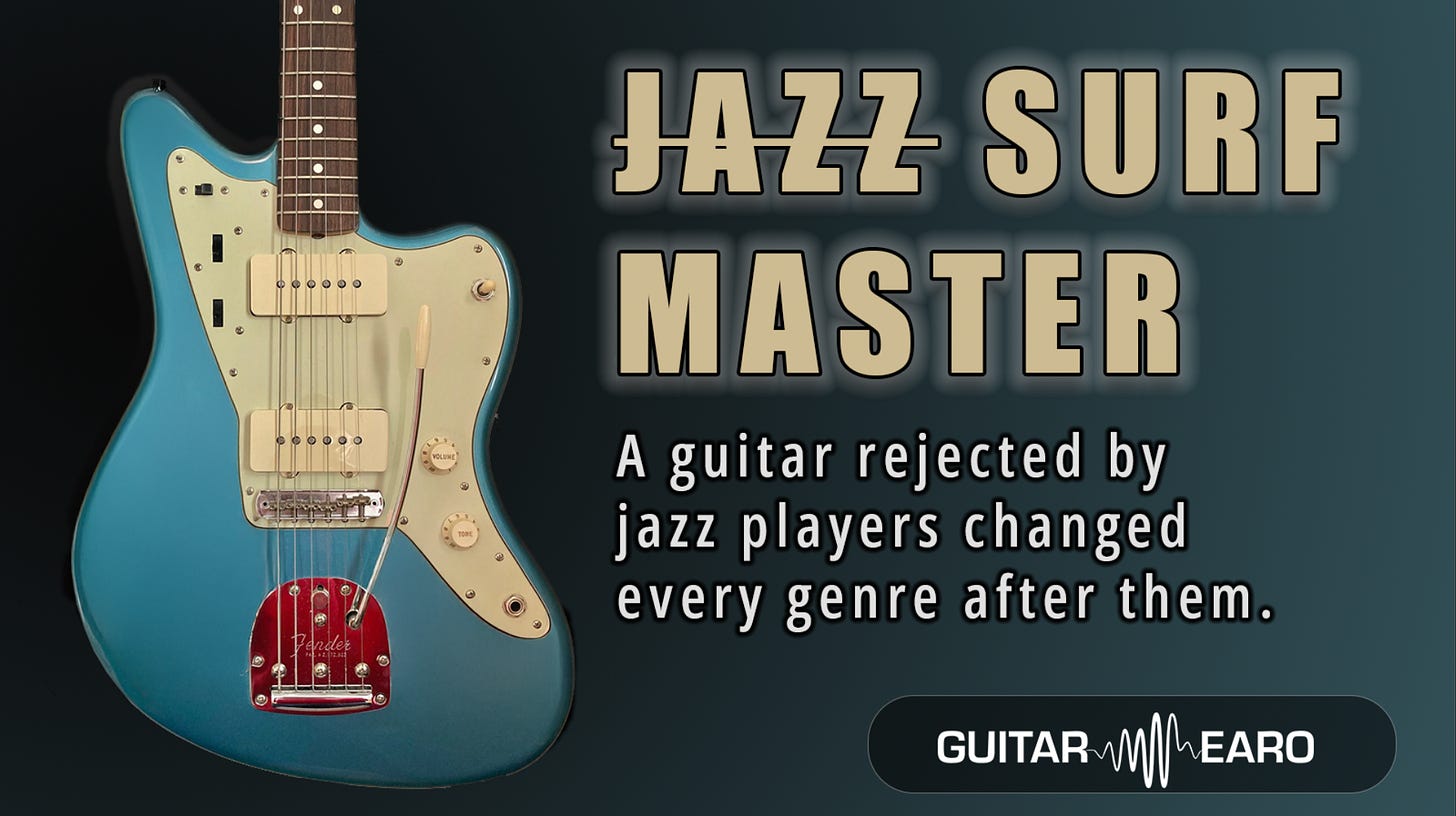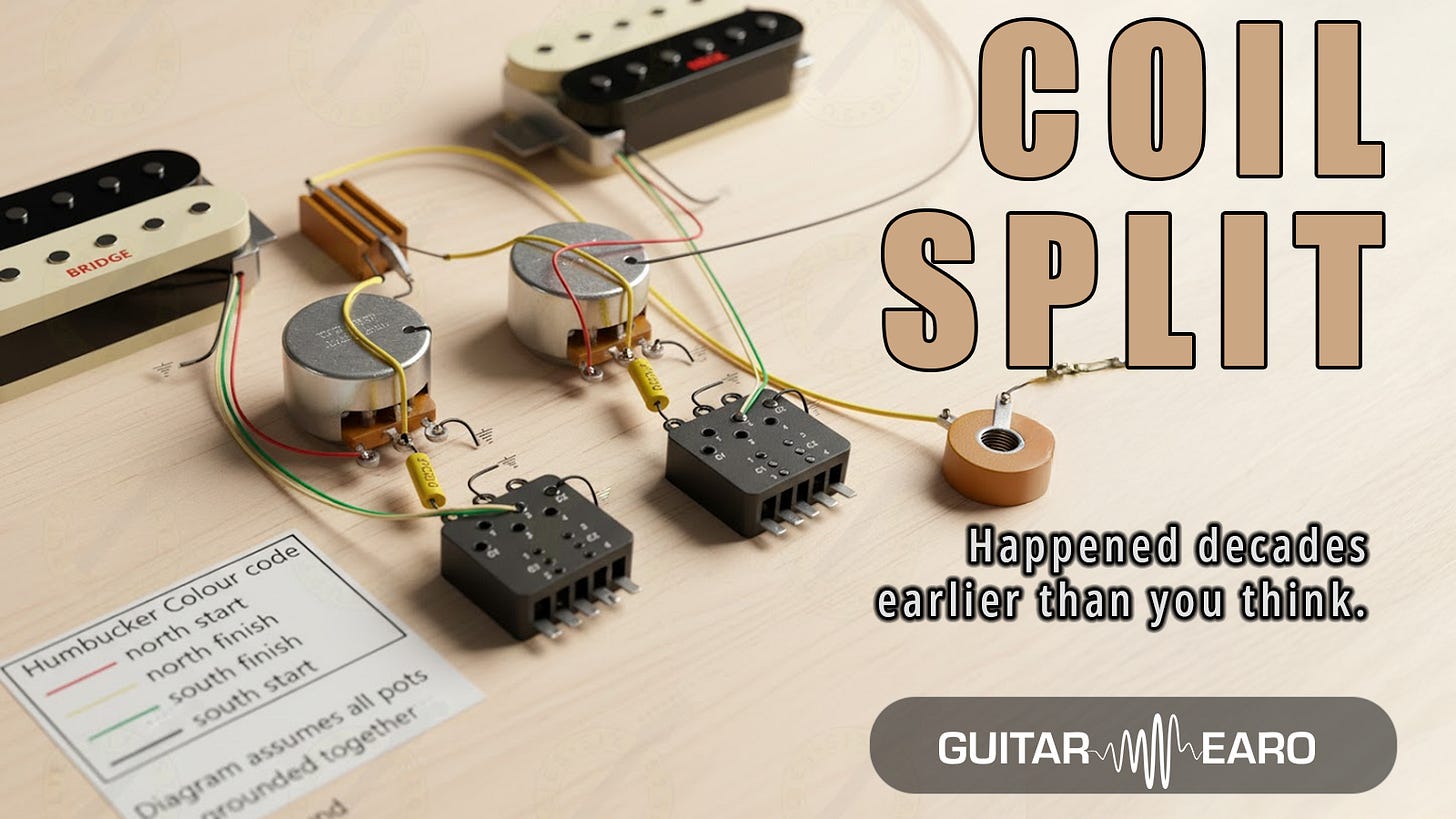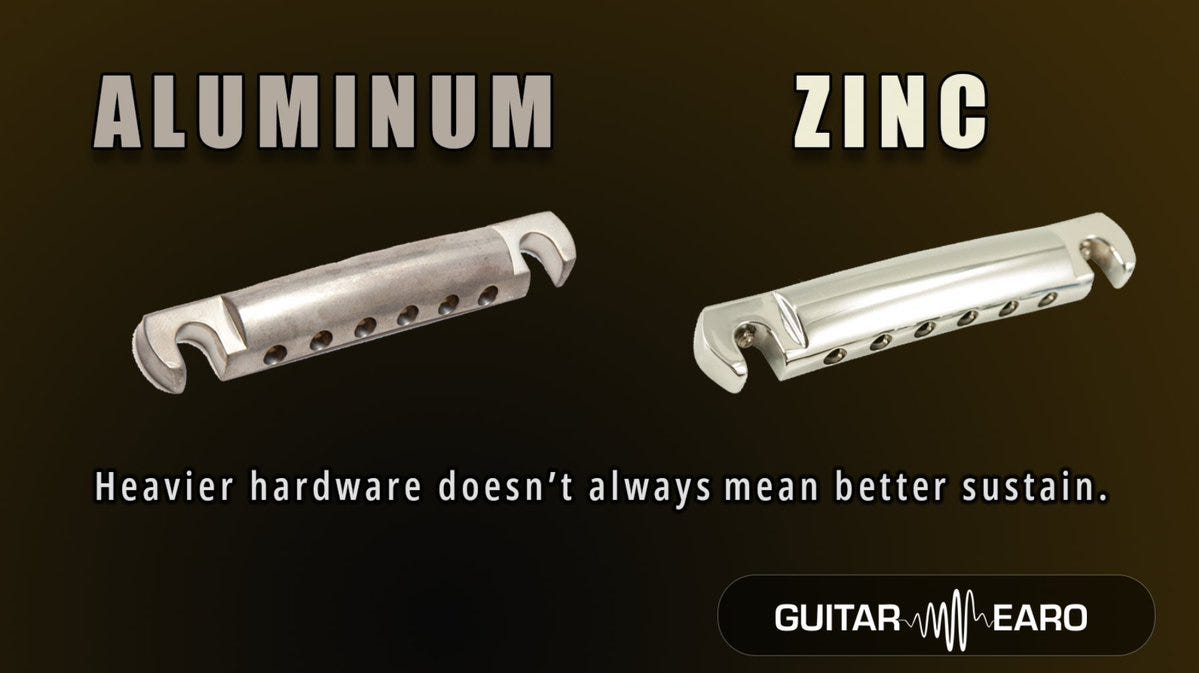I. Origins: George Van Eps and the “Complete Guitar” (1938)
The seven-string’s electric story begins not in metal, but in jazz orche<a href="can-you-hear-the-difference-strat.html">strat</a>ion.
In 1938, Epiphone built a custom 7-string archtop for George Van Eps, designed specifically to extend the guitar’s bass range. The added low A string (A1, 55 Hz) allowed him to comp bass lines while simultaneously voicing chords and melodies. Van Eps’s own method book, Harmonic Mechanisms for Guitar, codified this approach: treating the guitar as a polyphonic instrument with three registers.
Technically, this was a monumental step. Standard jazz tuning (E–A–D–G–B–E) limited true counterpoint. Adding the low A gave Van Eps access to intervallic spreads below the C2 line, traditionally reserved for upright bass. He referred to the instrument as “the complete guitar”: a fusion of chordal and bass functionality.
However, the amplification of the era, primitive single-coil archtop <a href="high-vs-low-the-eternal-pickup-output.html">pickups</a> and narrow-band amps, meant that sub-100 Hz frequencies were barely captured, often lost to transformer roll-off. The technology simply wasn’t ready to render the low string cleanly.
Subscribe to Guitar Earo’s Substack for tone archaeology like this: real data, not lore.
II. Dormancy and Isolation (1950s–1980s)
By the 1950s, Gretsch built Van Eps another 7-string, with improved <a href="high-vs-low-the-eternal-pickup-output.html">pickups</a>, but the instrument remained niche. In magnetic pickup design, the challenge was obvious: a standard humbucker’s magnetic aperture (roughly 50–52 mm spacing) did not account for the longer swing amplitude of the low string. Without compensating pole-piece geometry or coil width, low-frequency clarity suffered.
The few who adopted 7-strings in jazz (Howard Alden, Bucky Pizzarelli) did so with very heavy gauge strings (often .070–.074 for the 7th) and large hollow bodies to maintain acoustic resonance. Amplifiers like the Polytone Mini-Brute and Gibson GA-50 were tuned for midrange warmth, not sub-bass extension. The result was musical beauty, but technical limitation: the low string lacked articulation under gain.
For nearly fifty years, the 7-string remained a single-artist ecosystem, a specialized jazz tool for pianistic players.
III. The Paradigm Shift: Steve Vai’s Ibanez Universe (1990)
The 7-string resurfaced in a completely different world: high-gain rock and early digital production.
In 1990, Ibanez introduced the Universe UV7, a signature model for Steve Vai. This was the first mass-produced solidbody 7-string electric, and its design decisions read like an engineering response to Van Eps’s limitations:
Specification
Design Rationale
25.5” → 26.25” scale (later 26.5” typical)
Increased tension for low B (B0 ≈ 61.7 Hz)
High-output DiMarzio Blaze humbuckers
Extended magnetic window; low-frequency capture
Basswood body
Even response, reduced mid bump for better low-end clarity
5-piece maple/walnut <a href="why-i-do-not-have-a-stiff-neck.html">neck</a>
High stiffness to minimize resonant dead spots below 300 Hz
Locking tremolo (Edge 7)
Maintained tuning stability under increased string tension
Vai’s reasoning was musical and spectral: while recording Passion & Warfare, he sought a continuous tonal field from 60 Hz to 6 kHz, enabling bass-like extensions without losing treble definition. In rehearsals with Whitesnake (1989), he noticed that detuned 6-strings lost harmonic focus, so a dedicated 7th string became the cleaner solution.
IV. Tonal Consequences of the Low-B Revolution
Introducing a string tuned to B0 added an octave of content that challenged existing pickup, speaker, and amplifier topologies.
1.
Harmonic Distribution
A low-B (.059–.065 gauge) produces a dominant second harmonic around 123 Hz, meaning the perceived “body” of the note sits where 4×12” guitar speakers start to roll off. Traditional Celestion G12M drivers have a –3 dB point near 100 Hz, so early adopters reported “flub.” Amp designers later added resonance controls (e.g., Mesa Dual Rectifier) to recover low-end definition.
2.
Magnetic Coupling
The longer string excursion (~5.5 mm at the center of motion vs 4 mm on E2) required greater coil aperture and flux density management. Pickup builders extended pole spacing and modified magnet grade (often Alnico V or ceramic VIII) to maintain consistent field intensity across seven poles.
3.
Neck Resonance
Adding a lower string shifts the primary longitudinal mode of the <a href="why-i-do-not-have-a-stiff-neck.html">neck</a>–body system downward. Builders compensated with dual truss rods or carbon reinforcement to avoid sympathetic absorption near 277 Hz (the infamous “dead spot” region).
In short, the 7-string forced the entire signal chain, from pickup geometry to cabinet tuning, to evolve.
Get more tone-engineering breakdowns like this. Subscribe for deep-frequency insight.
V. Cultural Phase Transition: Metal and the “Bandwidth Arms Race”
Vai’s Universe begot the Korn and Meshuggah era (mid-’90s). These bands exploited the 7-string not as a melodic extension, but as a textural foundation. The genre’s shift from 440 Hz-centric writing to 60–100 Hz rhythm grids paralleled changes in studio production:
Low-cut filters dropped from 100 Hz → 60 Hz in guitar buses.
Cabs with extended low end (Mesa Rectifier 4×12, tuned ~70 Hz) became standard.
Scale lengths stretched to 27″ or more for string tension >17 lbs on the 7th.
By the early 2000s, even 8-strings appeared (F#0 ~46 Hz), effectively entering bass territory. The 7-string had normalized the concept of full-range guitar.
VI. A Fifty-Year Echo
The striking irony: George Van Eps’s 1938 goal and Vai’s 1990 goal were identical in principle, to merge registers. One sought pianistic harmony; the other, percussive sub-range aggression. Both innovations waited for technology and culture to align.
From transformer bandwidth to pickup aperture, each design leap solved the previous era’s bottleneck.
What was once a jazz tool became a modern production standard.
VII. Conclusion
The seven-string’s journey shows how instrument design is contingent on context. It took:
Fifty years of amplifier evolution,
Loudspeaker design extending to sub-70 Hz,
New materials (multi-laminate necks, carbon rods),
And a genre hungry for more low-end space.
Today, 7-strings and even 8-strings are normalised, but the DNA remains pure Van Eps: chasing completeness.
Subscribe to Guitar Earo on Substack for tone engineering, pickup physics, and forgotten design histories: the research-level side of guitar culture.




